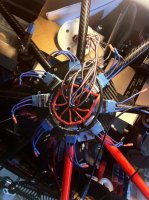Bartman
Welcome to MultiRotorForums.com!!
Surfing around the internet I'm looking at the different power distribution boards that are out there.
Photoship One makes one
http://photoshipone.com/shop/index.php?main_page=product_info&cPath=40&products_id=250
MultiWiiCopter makes one as well
http://www.multiwiicopter.com/products/voltair-esc-wiring-board
The one from PhotoshipOne is rated for 60 amps with one battery and 80 amps with two. So, if I understand this correctly, that's 10 amps max per set of motor connections if you're using two batteries? That doesn't seem like a lot considering the popular Tiger motors are rated to a max of 25 amps at 14.8 volts.
The MultiWii board is only rated to 60 amps (no mention of number of batteries is made).
It seems that the max amp rating is determined by what the battery contacts can handle. If the battery contacts are of the same design as the motor pads (like with the MultiWii board), then wouldn't using two pads per battery connection effectively double the rating? If I brought the negative from a battery into the board using two contacts and same for the positive, times two for two batteries, I'd have four sets of contacts supplying power to the board with each contact rated for 60 amps.
I have a simple wire harness already built but I'm trying to incorporate a power board just for ease of assembly.
Thanks,
Bart
Photoship One makes one
http://photoshipone.com/shop/index.php?main_page=product_info&cPath=40&products_id=250
MultiWiiCopter makes one as well
http://www.multiwiicopter.com/products/voltair-esc-wiring-board
The one from PhotoshipOne is rated for 60 amps with one battery and 80 amps with two. So, if I understand this correctly, that's 10 amps max per set of motor connections if you're using two batteries? That doesn't seem like a lot considering the popular Tiger motors are rated to a max of 25 amps at 14.8 volts.
The MultiWii board is only rated to 60 amps (no mention of number of batteries is made).
It seems that the max amp rating is determined by what the battery contacts can handle. If the battery contacts are of the same design as the motor pads (like with the MultiWii board), then wouldn't using two pads per battery connection effectively double the rating? If I brought the negative from a battery into the board using two contacts and same for the positive, times two for two batteries, I'd have four sets of contacts supplying power to the board with each contact rated for 60 amps.
I have a simple wire harness already built but I'm trying to incorporate a power board just for ease of assembly.
Thanks,
Bart

